Discrete Fourier Transform-Based Block Faster-Than- Nyquist Transmission for 5G Wireless Communications
Abstract
1. Introduction
- We first propose a DFT based block transmission for multicarrier FTN signaling scheme, i.e., DBT-MC-FTN, where the two-dimensional compression in both time-domain and frequency-domain can be realized efficiently by adjusting the operation parameters.
- CP-based channel frequency domain equalization and soft SIC detector are deployed respectively to eliminate the ISI and ICI introduced by the channel and the two-dimensional packing in the DBT-MC-FTN signaling. The effectiveness of the proposed detector is verified by the simulations.
- Based on the special structure of the proposed DBT-MC-FTN scheme, two pilot transmission schemes for channel estimation have been proposed. The two schemes are time-division multiplexing (TDM) non-orthogonal pilots and multiplexing orthogonal pilots in the same time-frequency resource, respectively. We demonstrate that time-domain estimation using non-orthogonal pilots performs better while other schemes have error floors when the simple least square (LS) algorithm is implemented.
2. System Model of DBT-MC-FTN
2.1. DBT-MC-FTN Transmitter
2.2. DBT-MC-FTN Receiver
2.3. Equalization Scheme
3. Proposed Channel Estimation Schemes
3.1. Scheme I: Channel Estimation Using DBT-MC-FTN Pilots
3.2. Scheme II: Channel Estimation Using Orthogonal Pilots
4. Simulation Results
4.1. CE Performance
4.2. BER Performance with SIC Equalization
5. Conclusions and Future Work
Author Contributions
Funding
Conflicts of Interest
Abbreviations
| AWGN | additive white Gaussian noise |
| BCJR | Bahl–Cocke–Jelinek–Raviv |
| BER | bit error rate |
| CE | channel estimation |
| CIR | channel impulse response |
| CP | cyclic prefix |
| CS | cyclic suffix |
| CSI | channel state information |
| DBT-MC-FTN | DFT based block transmission for multicarrier faster-than-Nyquist |
| DFT | discrete Fourier transform |
| FD-CE | frequency-domain channel estimation |
| FDE | frequency-domain equalization |
| FTN | faster-than-Nyquist |
| ICI | inter carrier interference |
| IDFT | Inverse Discrete Fourier transform |
| ISI | inter symbol interference |
| LS | least square |
| MAP | maximum a posteriori |
| ML | maximum likelihood |
| MMSE | minimum mean squared error |
| LMMSE | linear minimum mean squared error |
| OOBE | out-of-band emission |
| RRC | root-raised cosine |
| SIC | successive interference cancellation |
| SNR | signal-to-noise ratio |
| TD-CE | time-domain channel estimation |
| TDM | time-division multiplexing |
| TU | typical urban |
| ZF | zero forcing |
Appendix A. Notation
| the dth complex symbol modulated on the mth subcarrier | |
| frequency packing factor (FPF) | |
| time packing factor (TPF) | |
| M | the number of subcarriers |
| D | the number of the symbols transmitted on each subcarrier |
| Nyquist symbol interval | |
| shift interval of the filter | |
| L | the length of the time domain shaping filter |
| Q | the length of circular expanding |
| the output signal vector on the mth subcarrier before Q-point IDFT operation | |
| the output signal matrix on M subcarriers before Q-point IDFT operation | |
| / | Fourier/Inverse Fourier transform matrix |
| cyclic extension matrix with D-dimensional identity matrix | |
| the frequency-domain window matrix | |
| the mth cyclic shift matrix | |
| transmitted DBT-MC-FTN signal vector | |
| a matrix consists of M cyclic shift matrixes | |
| a diagonal matrix with diagonal element | |
| a signal matrix consists of signals on M subcarriers | |
| the equivalent matrix of the transmitter | |
| the receiver signals vector | |
| the additive white Gaussian noise (AWGN) with zero mean and the variance of | |
| a circulant matrix constructed by h | |
| a circulant matrix constructed by | |
| a circulant matrix with first column vector is | |
| the signal vector after demodulation | |
| the correlation matrix regardless of the effect of the channel | |
| the noise matrix contaminated by the demodulation matrix | |
| the equivalent channel matrix containing the transceiver and the channel | |
| -length pilot symbol vector |
References
- 3GPP TS 38.211 v 15.5.0. Physical Channel and Modulation. Rel. 15. March 2019. Available online: https://www.3gpp.org/release-15 (accessed on 14 February 2020).
- Mazo, J. Faster-than-nyquist signaling. Bell Syst. Tech. J. 1975, 54, 1451–1462. [Google Scholar] [CrossRef]
- Xu, T.; Darwazeh, I. Spectrally Efficient FDM: Spectrum Saving Technique for 5G? In Proceedings of the 1st International Conference on 5G for Ubiquitous Connectivity, Akaslompolo, Finland, 26–28 November 2014; pp. 273–278. [Google Scholar]
- Anderson, J.B.; Rusek, F. Improving OFDM: Multistream Faster-than-Nyquist Signaling. In Proceedings of the 4th International Symposium on Turbo Codes, Munich, Germany, 3–7 April 2011. [Google Scholar]
- Ghannam, H.; Darwazeh, I. SEFDM: Spectral Efficiency Upper Bound and Interference Distribution. In Proceedings of the CSNDSP 2018 11th IEEE/IET International Symposium on Communication Systems, Networks and Digital Signal Processing, Budapest, Hungary, 18–20 July 2018. [Google Scholar]
- Rashich, A.; Urvantsev, A. Pulse-Shaped Multicarrier Signals with Nonorthogonal Frequency Spacing. In Proceedings of the 2018 IEEE International Black Sea Conference on Communications and Networking (BlackSeaCom), Batumi, Georgia, 4–7 June 2018; pp. 1–5. [Google Scholar]
- Rusek, F.; Anderson, J.B. The two-dimensional Mazo limit. In Proceedings of the International Symposium on Information Theory, Adelaide, SA, Australia, 4–9 September 2005. [Google Scholar]
- Fagorusi, T.; Feng, Y.; Bajcsy, J. An architecture for non-orthogonal multi-carrier faster-than-nyquist transmission. In Proceedings of the 2017 15th Canadian Workshop on Information Theory (CWIT), Quebec City, QC, Canada, 11–14 June 2017; pp. 1–5. [Google Scholar]
- Fan, J.; Guo, S.; Zhou, X.; Ren, Y.; Li, G.Y.; Chen, X. Faster-Than-Nyquist Signaling: An Overview. IEEE Access 2017, 5, 1925–1940. [Google Scholar] [CrossRef]
- Wang, K.; Liu, A.; Liang, X.; Peng, S.; Zhang, Q. A Faster-Than-Nyquist (FTN)-Based Multicarrier System. IEEE Trans. Veh. Technol. 2019, 68, 941–947. [Google Scholar] [CrossRef]
- Abdoli, M.J.; Jia, M.; Ma, J. Turbo-coded single-carrier faster-than-Nyquist transmission. In Proceedings of the 2014 IEEE 15th International Workshop on Signal Processing Advances in Wireless Communications (SPAWC), Toronto, ON, Canada, 22–25 June 2014; pp. 170–173. [Google Scholar]
- Tajan, M.; Poulliat, C.; Boucheret, M. Circular Faster Than Nyquist: Transmitter and iterative receiver design. In Proceedings of the 2016 9th International Symposium on Turbo Codes and Iterative Information Processing (ISTC), Brest, France, 5–9 September 2016; pp. 241–245. [Google Scholar]
- Li, M.; Lai, S.; Peng, Y. A Circulated Block Transmission Scheme for FTN Signaling. Int. J. Commun. Netw. Syst. Sci. 2017, 10, 269–279. [Google Scholar] [CrossRef]
- Li, M.; Peng, Y.; Lai, S.; Tian, J. A DFT based block transmission scheme for FTN signaling. In Proceedings of the 2017 23rd Asia-Pacific Conference on Communications (APCC), Perth, WA, Australia, 11–13 December 2017; pp. 1–6. [Google Scholar]
- Li, S.; Bai, B.; Zhou, J.; Chen, P.; Yu, Z. Reduced-Complexity Equalization for Faster-Than-Nyquist Signaling: New Methods Based on Ungerboeck Observation Model. IEEE Trans. Commun. 2018, 66, 1190–1204. [Google Scholar] [CrossRef]
- Dasalukunte, D.; Rusek, F.; Owall, V. An Iterative Decoder for Multicarrier Faster-Than-Nyquist Signaling Systems. In Proceedings of the IEEE International Conference on Communications, Cape Town, South Africa, 23–27 May 2010; pp. 1–5. [Google Scholar]
- Peng, S.; Liu, A.; Fang, H.; Wang, K.; Liang, X. Turbo Frequency Domain Equalization and Detection for Multicarrier Faster-Than-Nyquist Signaling. In Proceedings of the 2017 IEEE Wireless Communications and Networking Conference (WCNC), San Francisco, CA, USA, 19–22 March 2017. [Google Scholar]
- Lin, H.; Lahbabi, N.; Siohan, P.; Jiang, X. An efficient FTN implementation of the OFDM/OQAM system. In Proceedings of the ICC 2015—2015 IEEE International Conference on Communications, London, UK, 8–12 June 2015. [Google Scholar]
- Shi, Q.; Wu, N.; Wang, H. Joint Channel Estimation and Decoding for FTNS in Frequency-Selective Fading Channels. In Proceedings of the Global Communications Conference, Washington, DC, USA, 4–8 December 2017. [Google Scholar]
- Cai, B.; Liu, A.; Tong, X.; Cheng, F. Training sequences design for channel estimation in FTN system using discrete Fourier transform techniques. IET Commun. 2017, 11, 2561–2565. [Google Scholar]
- Ozan, W.; Ghannam, H.; Xu, T.; Haigh, P.A.; Darwazeh, I. Experimental Evaluation of Channel Estimation and Equalisation in Non-Orthogonal FDM Systems. In Proceedings of the 2018 11th International Symposium on Communication Systems, Networks and Digital Signal Processing (CSNDSP), Budapest, Hungary, 18–20 July 2018. [Google Scholar]
- Osaki, S.; Nakao, M.; Ishihara, T.; Sugiura, S. Differentially Modulated Spectrally Efficient Frequency-Division Multiplexing. IEEE Signal Process. Lett. 2019, 26, 1046–1050. [Google Scholar] [CrossRef]
- Hirano, T.; Kakishima, Y.; Sawahashi, M. TDM based reference signal multiplexing for Faster-than-Nyquist signaling using OFDM/OQAM. In Proceedings of the IEEE International Conference on Communication Systems, Macau, China, 19–21 November 2015. [Google Scholar]
- Nopchinda, D.; Xu, T.; Maher, R.; Thomsen, B.C.; Darwazeh, I. Dual Polarization Coherent Optical Spectrally Efficient Frequency Division Multiplexing. IEEE Photonics Technol. Lett. 2015, 28, 83–86. [Google Scholar] [CrossRef]
- Gorbunov, S.; Rashich, A. BER Performance of SEFDM Signals in LTE Fading Channels. In Proceedings of the 2018 41st International Conference on Telecommunications and Signal Processing (TSP), Athens, Greece, 4–6 July 2018. [Google Scholar]
- Lee, B.; Kim, J.; Lee, H.; Shim, B.; Kim, Y.; Lee, J. Towards Faster-Than-Nyquist Transmission for Beyond 5G Wireless Communications. In Proceedings of the ICC 2019—2019 IEEE International Conference on Communications (ICC), Shanghai, China, 20–24 May 2019. [Google Scholar]
- Hu, Z.; Gao, S.; Shao, Y.; Chen, L.K.; Chan, C.K. A Robust Channel Processor for Faster-than-Nyquist Non- Orthogonal FDM Visible Light Communication Systems. In Proceedings of the 2018 European Conference on Optical Communication (ECOC), Rome, Italy, 23–27 September 2018. [Google Scholar]
- Isam, S.; Darwazeh, I. Robust channel estimation for Spectrally Efficient FDM system. In Proceedings of the International Conference on Telecommunications, Jounieh, Lebanon, 23–25 April 2012. [Google Scholar]
- Ahmed, S.I.A. Spectrally Efficient FDM Communication Signals and Transceivers: Design, Mathematical Modelling and System Optimization. Ph.D. Dissertation, University College London, London, UK, 2011. [Google Scholar]
- Ishihara, T.; Sugiura, S. Iterative Frequency-Domain Joint Channel Estimation and Data Detection of Faster-Than-Nyquist Signaling. IEEE Trans. Wirel. Commun. 2017, 16, 6221–6231. [Google Scholar] [CrossRef]
- Shi, Q.; Wu, N.; Ma, X.; Wang, H. Frequency-Domain Joint Channel Estimation and Decoding for Faster-than-Nyquist Signaling. IEEE Trans. Commun. 2017, 66, 781–795. [Google Scholar] [CrossRef]
- Ishihara, T.; Sugiura, S. Differential Faster-Than-Nyquist Signaling. IEEE Access 2018, 6, 4199–4206. [Google Scholar] [CrossRef]
- Xu, T. Bandwidth Compressed Waveform and System Design for Wireless and Optical Communications: Theory and Practice. Ph.D. Dissertation, University College London (UCL), London, UK, 2017. [Google Scholar]
- Ghannam, H.; Darwazeh, I. A Proposal for Scalable 5G New Radio Frames with Enhanced Throughput. In Proceedings of the 2019 IEEE 89th Vehicular Technology Conference (VTC2019-Spring), Malaysia, Kuala Lumpur, 28 April–1 May 2019; pp. 1–6. [Google Scholar]
- Tuchler, M.; Singer, A.C.; Koetter, R. Minimum mean squared error equalization using a priori information. IEEE Trans. Signal Process. 2002, 50, 673–683. [Google Scholar] [CrossRef]
- Ungerboeck, G. Adaptive Maximum-Likelihood Receiver for Carrier-Modulated Data-Transmission Systems. IEEE Trans. Commun. 1974, 22, 624–636. [Google Scholar] [CrossRef]
- Ghannam, H.; Darwazeh, I. Robust Channel Estimation Methods for Spectrally Efficient FDM Systems. In Proceedings of the 2018 IEEE 87th Vehicular Technology Conference (VTC Spring), Porto, Portugal, 3–6 June 2018; pp. 1–6. [Google Scholar]
- ESTI TS 100 910 V5.12.0. Digital Cellular Telecommunications System (GSM). Radio Transmission and Reception. Available online: https://standards.globalspec.com/std/10203394/etsi-ts-100-910 (accessed on 14 February 2020).
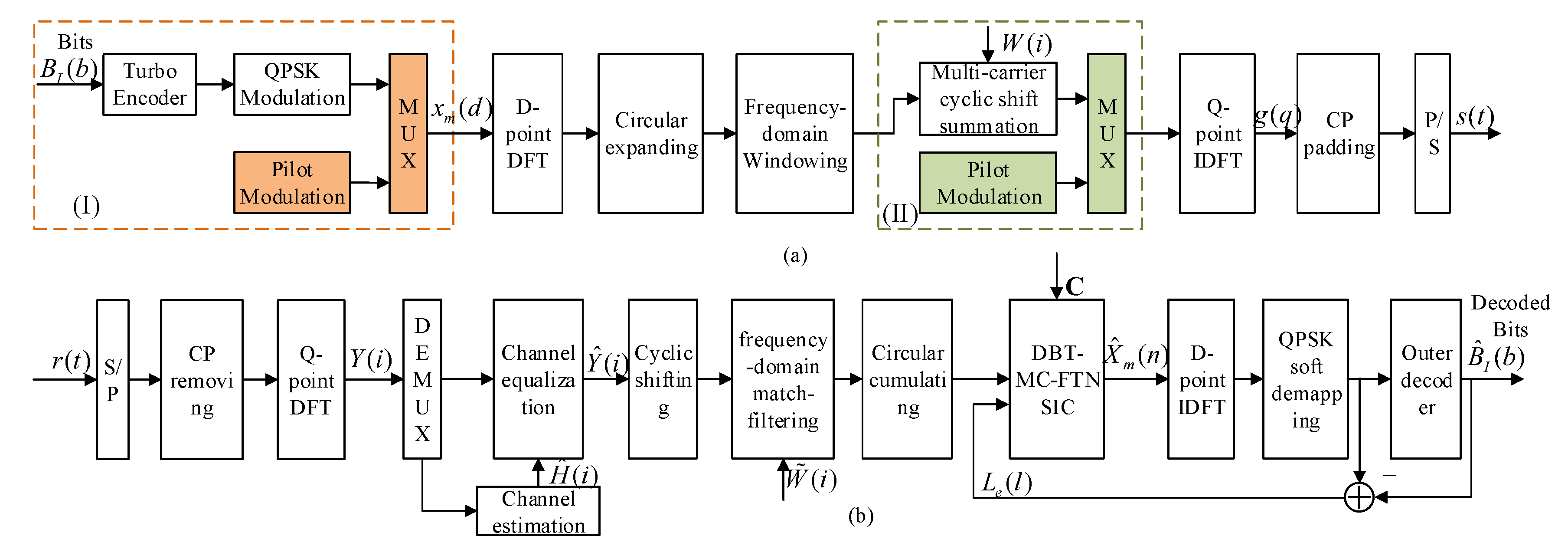

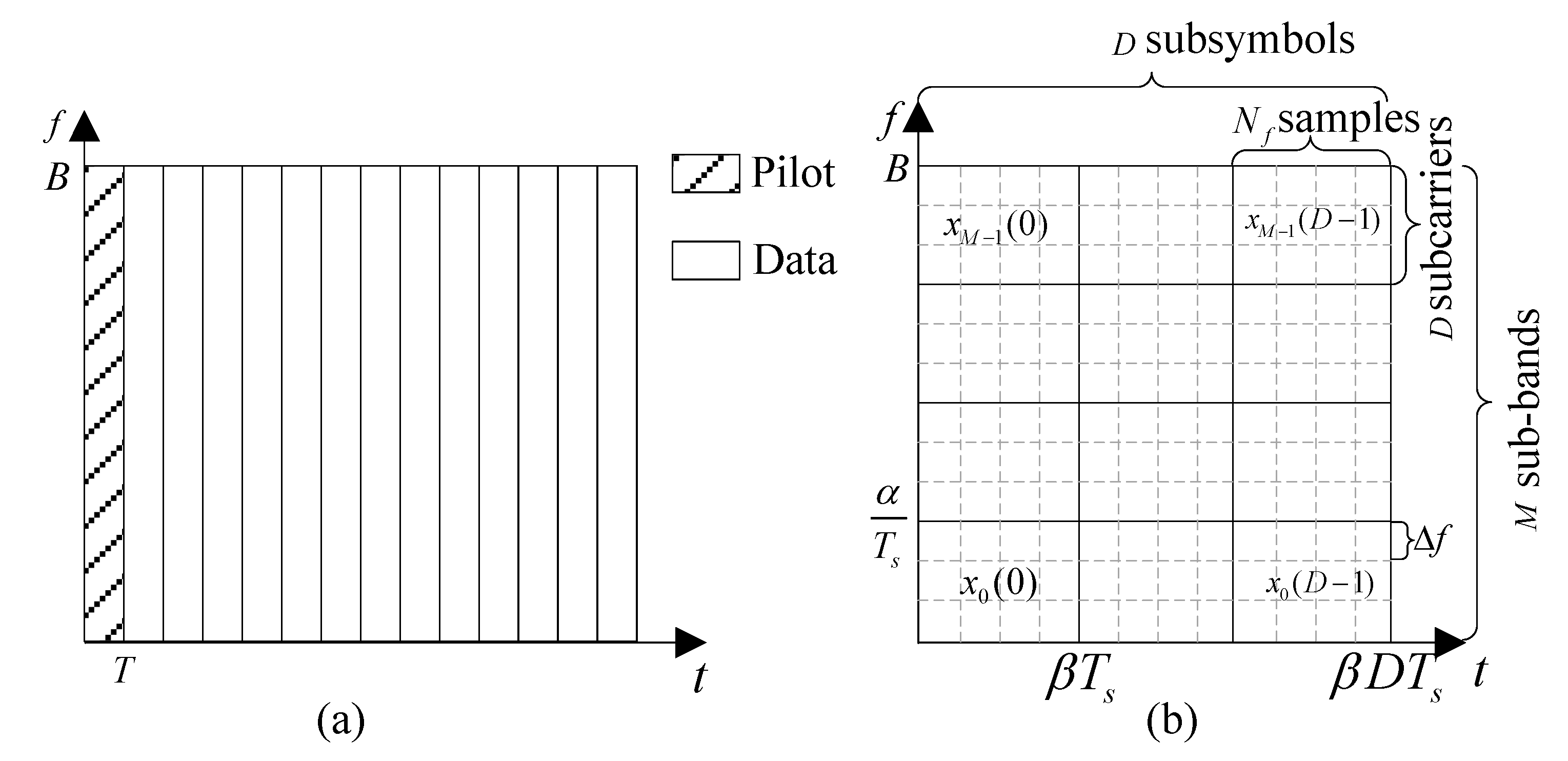
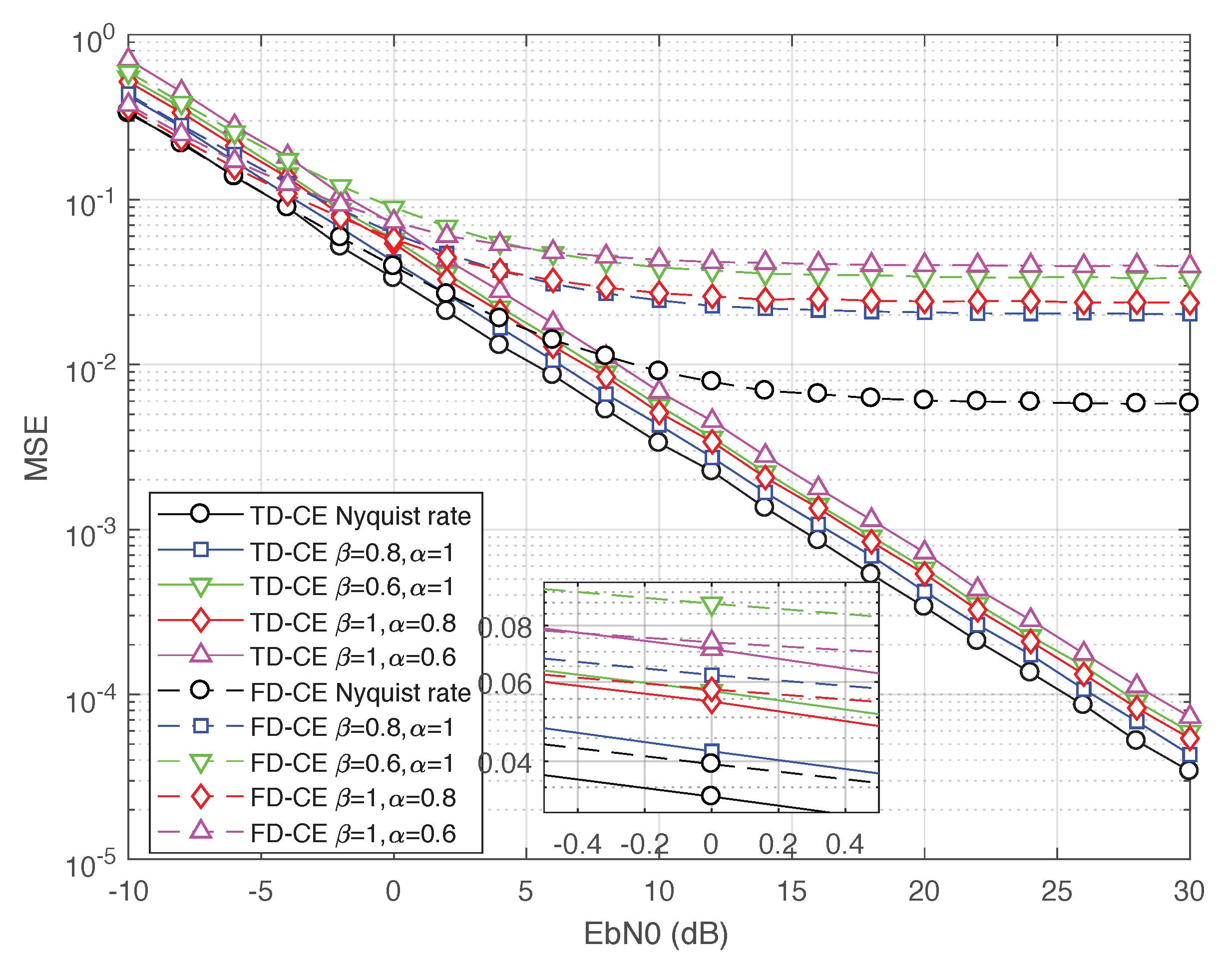
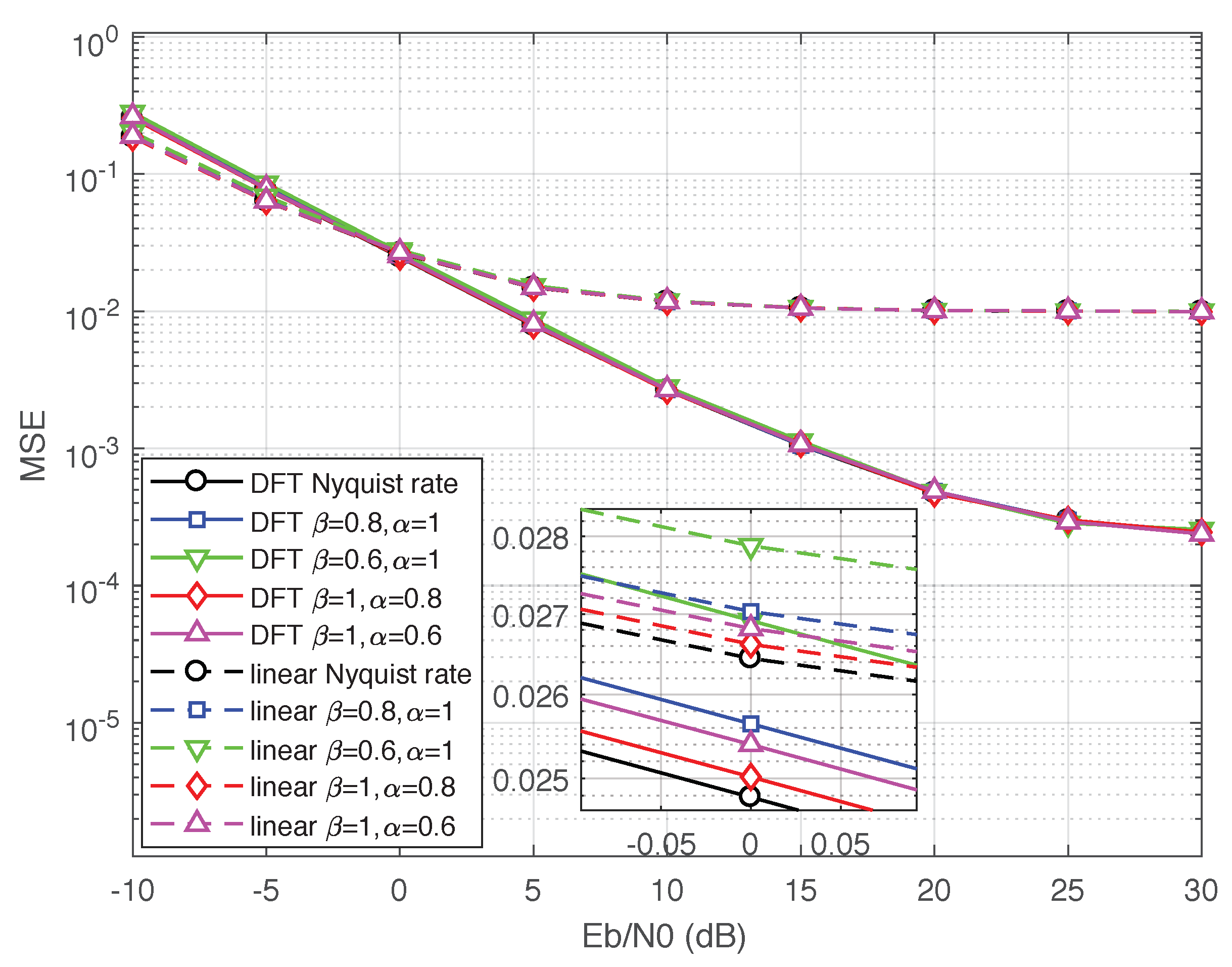
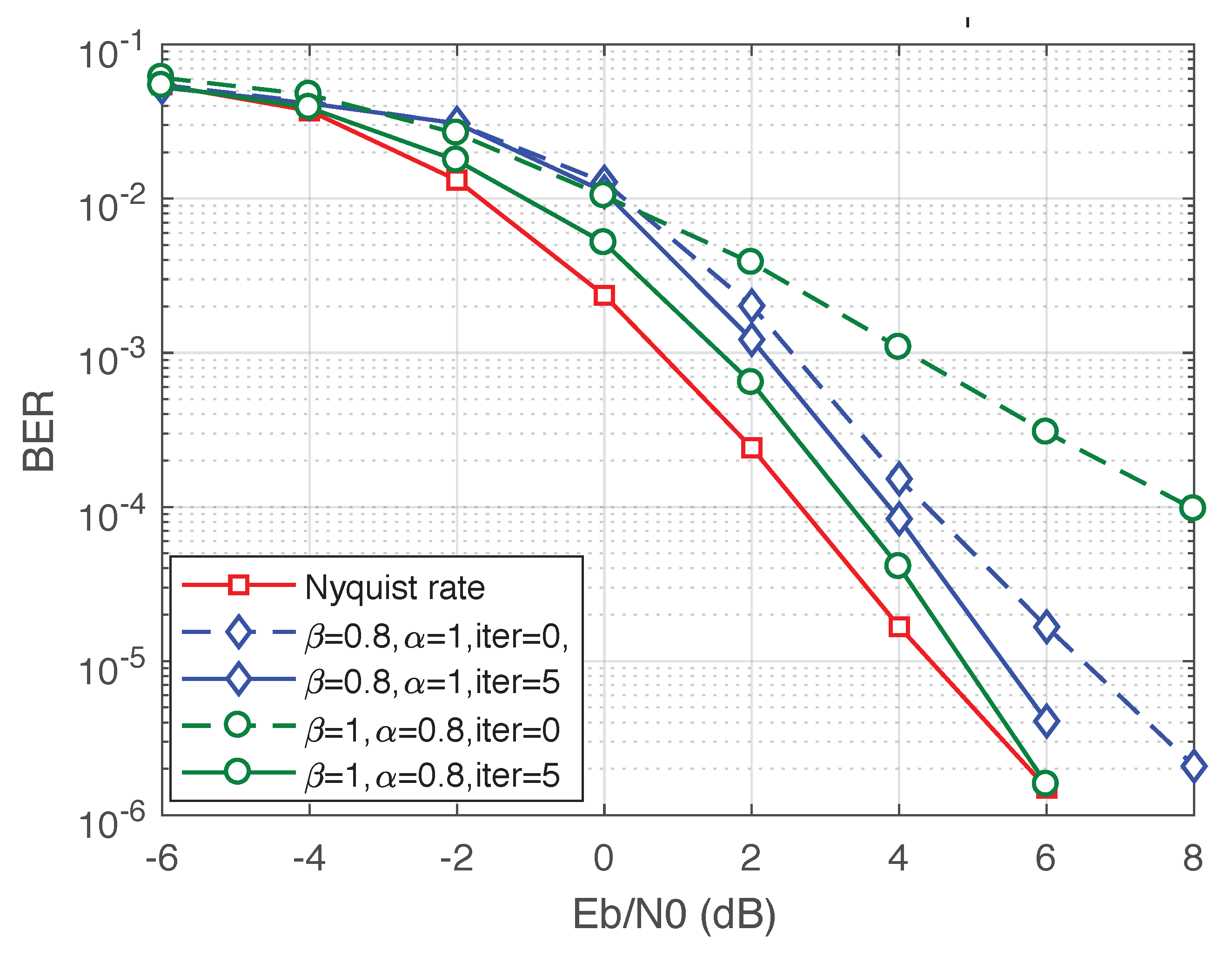
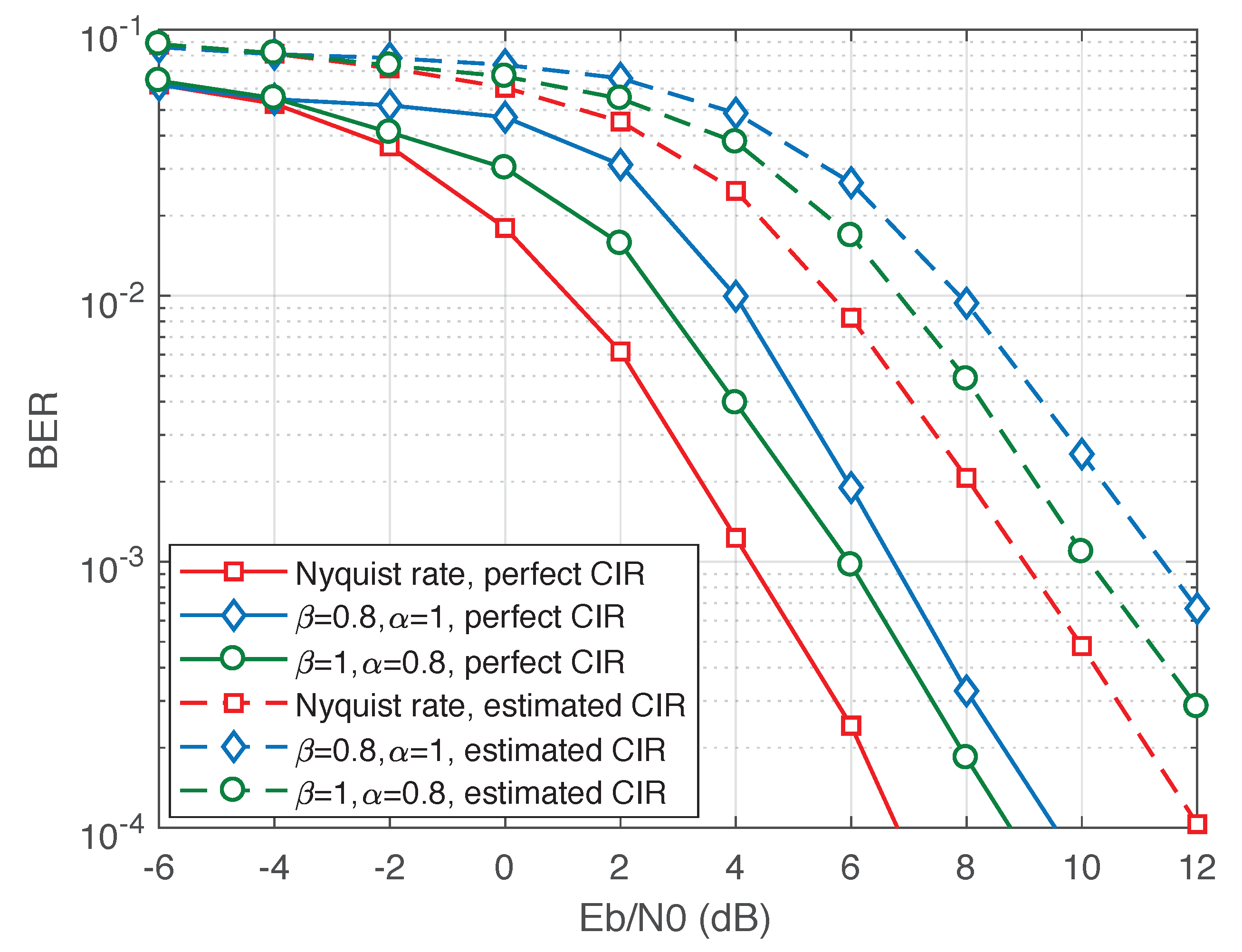
| Title 1 | Nyquist Rate Signaling | DBT-MC-FTN |
|---|---|---|
| Channel model | additive white Gaussian noise (AWGN) | AWGN |
| typical urban-6 (TU-6) | TU-6 | |
| Number of occupied subcarriers (M) | 16 | 16 |
| Number of the symbols transmitted on each subcarrier (D) | 30 | 30 |
| Inverse Discrete Fourier transform (IDFT) size (Q) | 900 | 540, 720 |
| Sampling frequency (MHz) | 15.36 | 15.36 |
| Modulation scheme | Quadrature Phase Shift Keying (QPSK) | QPSK |
| Type of pulse-shaping filter | root-raised cosine (RRC) | RRC |
| Roll-off factor of filter | 0.3 | 0.3 |
| Shift-orthogonal interval () | 30 | 30 |
| Shift interval of the shaping filter() | 30 | 18, 24 |
| Frequency packing factor (FPF, ) | 1 | 0.8, 0.6 |
| Time packing factor (TPF, ) | 1 | 0.8, 0.6 |
| Joint time-frequency packing factor (v) | 1 | 0.8, 0.6 |
| Spectral efficiency (bps/Hz) | 2 | 2.5, 3.33 |
© 2020 by the authors. Licensee MDPI, Basel, Switzerland. This article is an open access article distributed under the terms and conditions of the Creative Commons Attribution (CC BY) license (http://creativecommons.org/licenses/by/4.0/).
Share and Cite
Peng, Y.; Li, M. Discrete Fourier Transform-Based Block Faster-Than- Nyquist Transmission for 5G Wireless Communications. Appl. Sci. 2020, 10, 1313. https://doi.org/10.3390/app10041313
Peng Y, Li M. Discrete Fourier Transform-Based Block Faster-Than- Nyquist Transmission for 5G Wireless Communications. Applied Sciences. 2020; 10(4):1313. https://doi.org/10.3390/app10041313
Chicago/Turabian StylePeng, Yaqiu, and Mingqi Li. 2020. "Discrete Fourier Transform-Based Block Faster-Than- Nyquist Transmission for 5G Wireless Communications" Applied Sciences 10, no. 4: 1313. https://doi.org/10.3390/app10041313
APA StylePeng, Y., & Li, M. (2020). Discrete Fourier Transform-Based Block Faster-Than- Nyquist Transmission for 5G Wireless Communications. Applied Sciences, 10(4), 1313. https://doi.org/10.3390/app10041313





